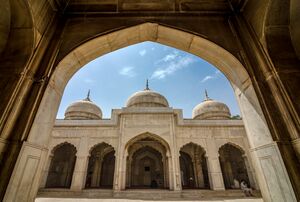مسجد موتي
| Moti Mosque | |
|---|---|
موتی مسجد | |
 | |
| الدين | |
| الارتباط | الإسلام |
| سنة البدء | 1630 |
| الموقع | |
| الموقع | پنجاب، لاهور، پاكستان |
| الإحداثيات الجغرافية | 31°35′18″N 74°18′50″E / 31.58847°N 74.313787°E |
| العمارة | |
| النوع المعماري | مسجد |
| النمط المعماري | المغل |
| اكتمل | 1635 |
| القباب | 3 |
مسجد موتي ( Moti Masjid ؛ پنجابي وأردو: موتی مسجد)، هو أحد "المساجد اللآلئ"، وقد بُنيَ في القرن السابع عشر داخل حصن لاهور، لاهور، پنجاب، پاكستان. وهو مبنى صغير من الرخام الأبيض بناه سلطان المغل جهانگير وعدّله معماريو شاه جهان،[1] وضمن إضافاته البارزة (مثل شيش محل و مقصورة نولكها) إلى مجمع حصن لاهور.[2] يقع المسجد على الجانب الغربي لحصن لاهور، أقرب إلى بوابة علمگيري، المدخل الرئيسي.
أصل الاسم
موتي بلغة الأردو تعني لؤلؤة، which designates a perceived preciousness to the religious structure. It was an established practice among Mughal emperors to name the mosques after generic names for gemstones. Other such examples are the Mina Masjid (Gem Mosque) and Nagina Masjid (Jewel Mosque), both located in Agra Fort and completed in 1637 under Shah Jahan's reign.[3] The mosque, built between 1630 and 1635,[4] is the first among the "pearl" named mosques, the others built by Shah Jahan in Agra Fort (1647–53), and his son Aurangzeb في الحصن الأحمر (1659–60).
التاريخ التالي
After the Mughal Empire, the mosque was converted into a Sikh temple and renamed Moti Mandir during the period of the Sikh rule under Ranjit Singh's Sikh Confederacy (1760–99).[5] Later, Ranjit Singh also used the building for the state treasury. After the demise of Sikh Empire, when the British took over Punjab in 1849, they discovered precious stones wrapped in bits of rags and placed in velvet purses scattered inside the mosque, along with other inventory.[6] The building was later revived to its former status, and the religious relics were conserved at the nearby Badshahi Mosque.
التصميم
The structure, located in the northwestern corner of ديوان عام quadrangle, is typical of Mughal architecture of Shah Jahan's times.[7] It is completely built of white marble الذي جـُلِب من مكرانا.[4] The façade is composed of cusped arches and engaged baluster columns with smooth and fine contours.[8] The mosque has three superimposed domes, two aisles of five bays, and a slightly raised central pishtaq, or portal with a rectangular frame.[9] This five-arched facade distinguishes it from other mosques of the similar class with three-arched facades. The interior is simple and plain with the exception of ceilings that are decorated and designed in four different orders, two arcuate, and two trabeated.[10]
الهامش
- ^ Ahmad Nabi Khan (1991). Development of Mosque Architecture in Pakistan. p. 71. ISBN 9789694680088.
- ^ Nadiem (2004)
- ^ Koch 1991, p. 121-22)
- ^ أ ب Nath (1982), p. 422
- ^ Dar, Nadeem (20 June 2015). "A pearl inside Lahore Fort – Moti Masjid". Pakistan Today. Retrieved 6 January 2017.
- ^ Zaman, Mahmood (2002). The Login inventory of the Lahore Fort. Dawn. 25 January. Retrieved 16 April 2008
- ^ Koch (1982)
- ^ Lahore Fort Complex: Moti Masjid Archived 25 مايو 2011 at the Wayback Machine at ArchNet. Retrieved 16 April 2008.
- ^ Koch (1991), p. 123
- ^ Nath (1982), p. 423
انظر أيضاً
المراجع
- Asher, Catherine E G (1992) Architecture of Mughal India. Cambridge University Press. ISBN 0-521-26728-5
- Koch, Ebba (1982) The Baluster Column: A European Motif in Mughal Architecture and Its Meaning. Journal of the Warburg and Courtauld Institutes, Vol. 45, p. 251-262 JSTOR 750984
- Koch, Ebba (1991). Mughal Architecture: An Outline of Its History and Development, 1526–1858. Prestel. ISBN 3-7913-1070-4
- Nadiem, Ihsan H. (2004). Forts of Pakistan. Al-Faisal Publishers. ISBN 969-503-352-0
- Nath, Ravinder (1982). History of Mughal Architecture. Abhinav Publications. ISBN 81-7017-414-7
وصلات خارجية
- Digital Library of Moti Masjid at ArchNet.
- تحويل قالب:مدينة لاهور المسورة
- Pages using gadget WikiMiniAtlas
- Short description is different from Wikidata
- Coordinates on Wikidata
- Articles with hatnote templates targeting a nonexistent page
- Articles containing أردو-language text
- Pages using Lang-xx templates
- قوالب مواقع التراث العالمي في پاكستان
- مباني ومنشآت دينية اكتملت في 1635
- حصن لاهور
- مساجد لاهور
- مواقع التراث العالمي في پاكستان
- تأسيسات 1635 في آسيا
- مساجد المغل

